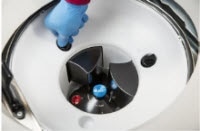Beckman Coulter introduced the first AUC sample characterization instrument to help the scientific community power new discoveries. That tradition continues into the 21st century with the new Optima AUC system.
This latest tool is the most robust technology for providing data used to determine protein molecular weight in basic protein research and quantification of aggregation levels for academic and biopharma research.
The results of AUC are explicit, reliable, and reproducible. AUC is my method of choice to characterize macromolecules and precisely study protein-protein interactions.
Jia Ma, Ph.D. Director, Bioanalytical Core, Purdue University
Product features and benefits
The Optima AUC combines the power of a centrifuge to provide particle sedimentation with the functionality of optical modules to detect the sedimentation over time. It provides the data you need even faster, so you can make new discoveries in less time.
Summary of features and benefits:
- Enables sample recovery
- Avoids dilution effects
- Analyzes samples in a matrix-free environment
- Has minimal buffer constraints
- Enables detection at low concentrations
- Requires low sample volume (0.1 mL minimum)
- Delivers high-throughput analysis – up to 7 samples in a single run
- Requires no standards – relies upon first principles of thermodynamics
Versatility
- Analyzes a wide array of particles in native, matrix-free conditions, including:
- Proteins
- Nanoparticles
- Peptides
- Polymers
- Micelles
- Liposomes
- Extracellular
- vesicles
- Drug conjugates
- Viral payload
- Provides data which can answer more critical questions than any other comparable technique, including:
- Shape
- Mass
- Diameter
- Stoichiometry
- Heterogeneity
- Association
- Aggregation
- Purity
- Formulation
- Enables precise analysis of complex systems at discrete wavelengths (up to 20) in minimal time.
Time Savings
- Generates faster results as acquisition time is no longer additive.
- Provides even more scans with the use of an An-50 Ti 8-hole rotor.
Ease of Use

- Optima AUC - Ease of Use
- Modular design provides absorbance and interference optical systems—with the option to install up to 3 independent, simultaneous detection systems (see photo).
- User-friendly touchscreen display indicates intuitive progression of experimental design.
- Remote monitoring capabilities let you set up, monitor and extract data from virtually any location.
- Compatibility with ProteomeLab XL cells and rotors—and widely used analytical software (e.g., UltraScan, SEDFIT/SEDPHAT, SEDANAL, DCDT+)—helps simplify the upgrade process.
Data Quality
- Delivers cleaner data by providing higher radial resolution and higher signal-to-noise ratio.
- Delivers higher precision, reproducibility and accuracy than the ProteomeLab XL.

Optima AUC Specifications
The Optima AUC is manufactured in the USA in an ISO 13485-registered facility and designed/tested to meet standards and regulations of CE mark and CSA when used as a complete system of ultracentrifuge, rotors and labware.
Centrifuge
| Speed range |
1,000 − 60,000 RPM in 100 RPM increments |
| Maximum RCF |
289,848 x g |
| Ambient temperature range |
10° - 30°C |
| Noise level (1 m in front of instrument) |
< 60 dBA |
| Vacuum level |
< 5 µm (0.7 Pa) |
| Max heat output under steady-state conditions |
3,400 Btu/hr (1.0 kW |
| Operating system |
LINUX |
| For remote monitoring: |
GUI (any OS) |
| Display screen |
15.3" |
| Dimensions |
94 cm (37") wide
84 cm (33") deep
133 cm (52.4") tall
|
| Weight |
1,000 kg (2,205 lb)
|
Optical systems
| Data acquisition rate ABS |
< 7 seconds/sectori |
| INT |
< 5 seconds/scan |
| Maximum # of wavelengths |
20 (190 nm - 800 nm)
|
| Wavelength precision |
± 0.5 nm |
| Lowest radial resolution |
10 µm |
| ABS flash lamp frequency |
300 Hz |
| ABS dynamic range |
0.1 O.D. < c < 1.5 O.D. |
| CCD camera specifications |
2048 x 1088 pixels |
| Interference fringes |
≥ 10 fringes/cell |
| Usable concentration ranges |
ABS: 0.005 - ~ 1-2 mg/mL LH
INT: 0.25 - ~ 4-5 mg/mL BSA
|
Software
| Maximum unique users/passwords |
50 |
| Maximum user‐defined programs |
1,000 |
| Automated calculations |
Pelleting time
Concentration measures
Refractive index
Speed reduction
Sedimentation coefficient
|
| Language options |
English
Spanish
FrenchGerman
Italian
Chinese (simplified)Japanese
Korean
Russian
|
For the first time, these advanced features enable revolutionary new multi-wavelength experiments, an entirely new class of experimental designs that can exploit the presence of multiple chromophores in complex mixtures through spectral decomposition.
Borries Demeler
The University of Texas Health Science Center
i At optimal rotor speeds and 10 µm radial resolution